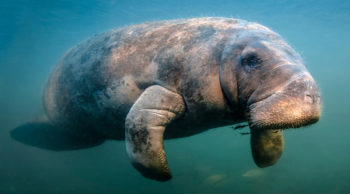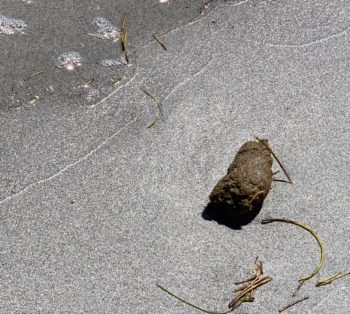UPDATE: Fecal Deposits Confirmed as Neither Human Nor Dog
Annali HaywardNovember 12, 2019
Nov. 12 — As fecal deposits continue to periodically wash ashore, Key Biscayne Public Works department staff collected a sample Nov. 1 and had it analysed for its DNA makeup, to pinpoint the source.
Results came in Nov. 7 and were released today. The tests were negative for both human and dog-related gene biomarkers.
As Key News reported Sept. 30, local wildlife expert Art Yerian believes the deposits come from manatees.
Yerian confirmed Friday the manatee population has not increased, however residents have reported more frequent sightings both off the beach and under the Mashta Island bridge.
Helena Solo-Gabriele, the lead professor on the Village-funded University of Miami water study, said she was not aware of any biomarkers available to test specifically for manatees, but that they are mammals and therefore “they could be a source as well.”
Sept. 30 — Good news for wildlife lovers. According to Art Yerian, manager of Bill Baggs Cape Florida State Park, what resident Natalia Mendoza found on Sept. 24 is in fact manatee excrement.
Yerian was previously in charge of all manatees and wildlife at Homosassa Springs Wildlife Park and served on a manatee rehabilitation team for 16 years. He said the pieces Mendoza saw would have broken off from larger parts.

Manatee – Adobe stock image
“We get them here at the park all the time,” he said. “Sometimes in herds, sometimes one or two. They come cruising through the harbor, eating seagrass. If you look at the specimen you can see it.”
Yerian confirmed there is nothing unusual or seasonal about the occurrence, and that it poses no threat to people or other wildlife. “It just gets washed back and the fish will eat it.”
Sept. 24 — A Key Biscayne resident’s regular beach walk was interrupted Tuesday by an unsavory discovery. Natalia Mendoza was walking around 12:30 p.m. from Key Colony to the Lighthouse when she saw something small, brown, and distinctly shaped.
“At first I thought it was just a one-off, but then I saw another one and another one,” said Mendoza. She says she saw at minimum six, but perhaps 10 specimens all along the water line, spaced out at intervals. “Sometimes one, then two together,” she said.
“I am not usually an alarmist person, I went in even after they said there were crocodiles and sharks,” continued Mendoza, a Tidemark resident. “But now it is so sad that my apartment is right on the beach and I can’t even go in the water.”

KB resident Natalia Mendoza took this single photo Tuesday, Sept. 24 after seeing feces on Key Biscayne Beach. Mendoza says she saw up to ten specimens on her walk. (Natalia Mendoza via Key News)
Key Biscayne’s beaches have been plagued by unsafe water warnings recently. While there is no evidence that Mendoza’s discovery is linked to the high bacterial counts, it may be cold comfort for Key residents hoping to enjoy their beach.
In the chats where Mendoza shared her photograph, residents commented they have seen dogs on the beach recently – a practice that is usually not permitted.
But Mendoza was dubious: “If it were an animal why would there be so many, all along the shore in a regular line?”
Jake Ozyman, Key Biscayne Public Works Director, immediately put out a call to his maintenance supervisor to investigate the sighting. He confirmed this is the first case that has been reported.
“Someone would literally have to just do this right there for it to be in that condition,” said Ozyman. “The human waste from pumps and pipes is already disintegrated.”
Mendoza said she’ll still walk on the beach, but “I definitely won’t go in completely for a while!”


